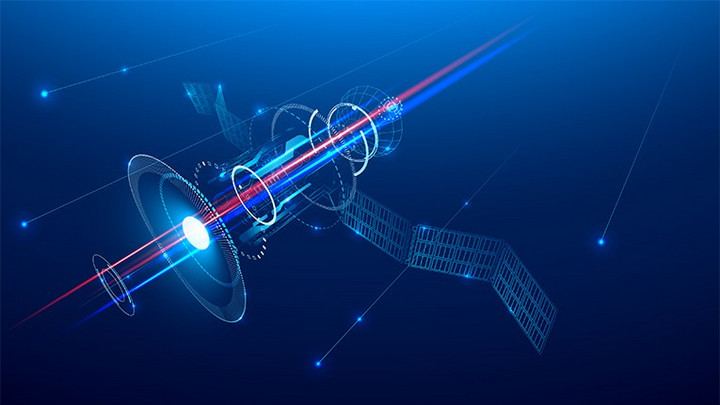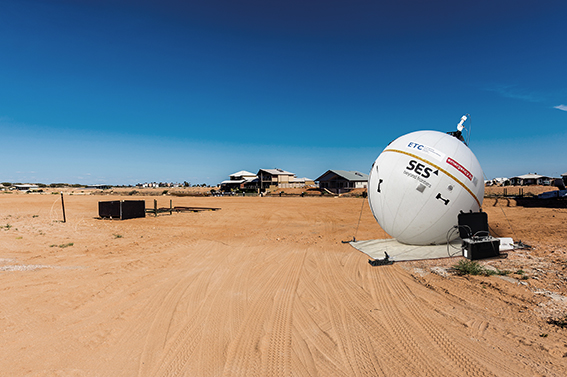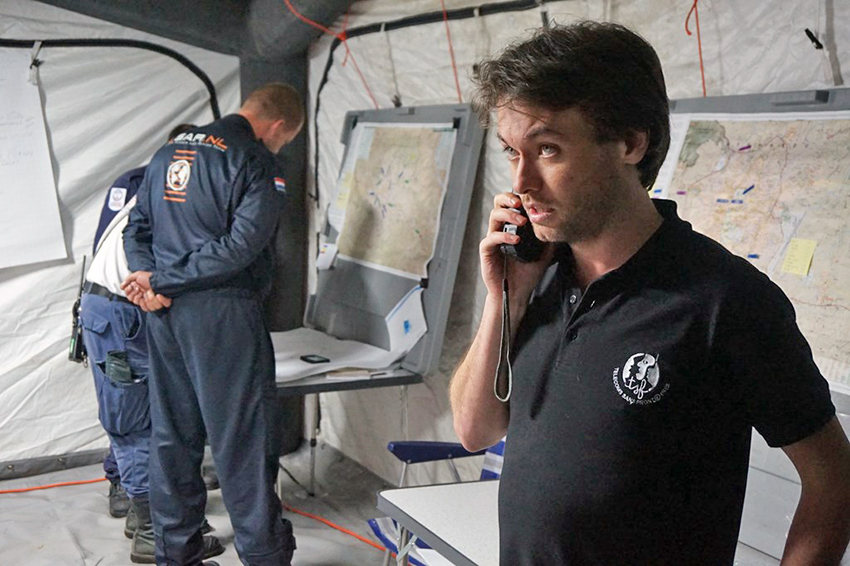The Space Tech Revolution & Global Entertainment Networks
Markus Payer, Vice President Corporate Communications & PR at the satellite operator SES, talked to dotmagazine about changes in the consumption and provision of TV programming, satellite communication, and innovations in space technology.

© Andrey Suslov | istockphoto.com
DOTMAGAZINE: How has the consumption of live sport changed over your networks in the last couple of years, and what changes are you anticipating around the corner?
MARKUS PAYER: Well, we have to say, first of all, that satellite was, and is, and will always be, the ideal means and the ideal infrastructure for transmitting live sport to millions and millions of viewers. And so, it has its place and its function and its importance in our video business, and if there is one reason for satellite videos to beat all records, then it is live transmission.
No other infrastructure can have the flexibility and the enormous reach, whilst doing this in highest quality, in HD quality and soon in ultra HD, and live sports is of course an important element in nearly all pay TV platforms. And since we are one of the biggest delivery infrastructures for pay TV platforms and of pay TV packages, sports and live sports especially is an important piece of it.
I'm actually talking about what has not changed, to get back to your question. What has not changed is the importance of satellite live sports in the program mix. Think of a sports event that you get through a pay TV package and you pay your monthly fee to get it, and they pay hundreds and hundreds of millions for the sports rights. You watch this on your big screen, you want to see every detail, you watch this in HD quality. You cannot conceive to have this in this depth and quality through another infrastructure. You cannot imagine having this delivered to millions and millions of viewers live, in real time, without a world-wide-waiting sand clock on your screen. Now, what has changed is on which screens people want to watch, and everybody does that in the meantime. You just look into a normal household today, how many screens you find and there is the big screen in the living room, like a kind of fireplace – there's a tablet, there are laptops, and hand-held smartphones, and so on.
These different screens also want different formats. I'm talking technically of course and I'm also talking content-wise. They need to be coded differently, but they also need to be edited differently. And, of course, behind this is the different exploitation strategy of the rights management. So, what has changed is that somebody like us (at least we believe this), if we want to stay in the pole position, to use that term from sports, we have to deliver to all of these screens. We have to be able to say to broadcasters, and this is especially true for those who have live sports, because they would normally be the absolute premium broadcasters. We have to be able to say: "Hey, you can deliver to any kind of screen, we'll take care of it". Because from their perspective, they don't want to know whether it's satellite or not, they just want to know that the signal is on the screen. And we don't want to say to our customers: “If you want a Greek salad, buy the tomatoes in shop A, and the cucumbers in shop B, and the cheese in shop C”. If we want to give it, we want to sell it all, we want to sell the entire product.
DOT: SES provides pay TV content to end-customers, but in what ways are you also providing Internet services for streaming of other content and for surfing online?
PAYER: The first thing to say is that it's not our pay TV content. We are not stepping into our customers' business. So, we are not buying program rights. We are distributing. We are looking at bringing it to people on all the different platforms, bringing it from orbit directly into the dish on your roof, bringing it into head-ends of cable networks, so that you actually think you are watching cable but you are using satellite behind it, and many cable networks are using satellite to get the feed. And as I said, also delivering to streaming and video on demand platforms.
So now, here it depends on what we are talking about if we talk of Internet and streaming. What we need to differentiate maybe is what we call the video business and what you would consider as a classical video business and as an online and a new and next-generation video business. Internet and streaming are, of course, today an integral part of it.
What we also have is a data business which is not acting for broadcasters but acting for all other kinds of enterprises, institutions, governments, airplane companies, maritime, and so on – mobility in that sense. So we’re talking about people who need a signal, who need connectivity, and who need high throughput, because they want to run their business online through streaming information and big data or they have users on board who want that.
There is obviously an element where, if you go on to a cruise ship today at Port Canaveral in Florida, for instance, and embark on the "Quantum of the Sea" cruise-ship of the Royal Caribbean – with 5000 people on board – you get to have a high speed Internet connection on board and you will of course probably in the evening watch something from Netflix on it, right?
That comes through our satellite. It comes through actually a beam sitting on one of our satellites following the ship wherever it goes like a torch. That's new technology. So you will never lose the contact on this ship, but you will do streaming from an end-consumer perspective. It's just that we look at it from a technical value-chain in a totally different way. But the end result, what we are doing is getting content to people.
DOT: So what exactly is the importance of satellite for governments and institutions, in your view?
PAYER: If you say government and institutions, you are actually addressing a very important field of activity and of growth for us. Governments and institutions have been using satellite capacity and satellite infrastructure for decades. In many cases, in many countries it even started like that because satellite was handled by the national post, was like an administration. It didn't start like that in Luxembourg because we went private right away with a state stake in it.
But it was obvious that, if you do this from the state angle, you are also using it for governmental institutional business. That was something natural from the very beginning. There's also something natural because defense and security and also linking and connecting institutions (for example, in the United Nations); for institutions that are really widespread over the globe – embassy networks, ministries – they obviously need to be connected, and you don't want to have pigeons flying back and forth anymore. You need a system.
The thing is that demand today is going through the roof because technologies are pulling more and more data throughput. If you just look at securing borders or observing geographies: the data, the high definition pixels that you get from these devices has multiplied and will multiply even more in the future. That means you need capacity; you need capacity to beam the pictures that you would catch up to the team sitting wherever on shore and observing it and using it. The U.S. Department of Defense, as such, is the largest buyer of commercial satellite capacity in the world. It's not a broadcaster. And the fact that these people who really need highly sophisticated systems come to us shows what an important role satellite plays in governmental and institutional infrastructures and connectivity strategies.
This sector has an important growth momentum, and there's maybe two things in the current geopolitical situation. First of all, there are a lot of geographies and conflicts to be observed, to be connected, to have troops connected, to have people connected, to have information exchange and so on; that's unfortunately our situation today. I'm talking not only about military, but also about emergency services, all of these catastrophes where suddenly everything is destroyed; you need connectivity from one day to the other for an entire country, like we had in the Caribbean with the hurricanes. You can bet that many nations, many countries will follow the American example in investing a lot into these infrastructures; it's a question of urgent need and positioning yourself. It's a question of national security, it's a question of policy making. There's a big trend to grow in this segment.
DOT: And speaking of growth and new developments, how much has changed in the area of space technology in recent times?
PAYER: It's a very important question and it's very good that you ask it, because we are at a moment where a couple of things in space technology are changing dramatically, all at the same time. This seemed to be a business 5 or 10 years ago which had seen its height, people felt: “It's stable, it works, it's reliable, but hey, we know it”. This has totally changed. There are some groundbreaking developments that actually will totally overhaul whatever people understand satellite connectivity or high throughput connectivity to be. To make it easy and understandable, you can say, “Hey: What do you need? Do you need the rockets? Right. And with the rocket you launch the satellite”. So on both, the rockets and the satellites, we have dramatic breakthroughs and technologically quantum leaps. Rockets are being produced in a way that they are much cheaper. This is largely thanks to Elon Musk in SpaceX, who has brought down the price for launches through efficiency systems in his factories. It's impressive.
In the next step, it's not only an economical factor, it’s not only that they are getting cheaper and you can have a SpaceX Falcon 9 – they say it on their website, so I'm not divulging secrets here – for a sixty million dollar list price. It's also that SpaceX started to re-use rockets and we've been the first in March this year to use a rocket a second time, to reuse it – for the first time ever. And this kind of recycling will become normal, and will again change the rocket industry, not only in the sense that launching becomes cheaper, but also the frequency gets better. We need a lot of rockets and of course if you can gain the first stage with motors back, they cost millions each, you'd refurbish it and use it again: you can go faster; access to space becomes easier. On satellite, there are a couple of developments which actually totally dissolve what this old model of: "Here's a satellite with solar rays; you launch it, it stands in geostationary position 36,000 kilometers away; you can never ever touch it again; it has its fuel on board; when the fuel is empty, the satellite is dead". This is changing. First of all, it changes because the size of the satellite changes and all the analog things that are on board today, they cause weight. And every kilo costs you 10,000 dollars to bring to space. So, every kilo costs a fortune. If you can change that, if you can digitize onboard and change the size and the weight, you will make a big change in your equation. And that happens today. The microprocessors on board – and I'm talking microprocessors that are so huge that you couldn't have expected them to come out in the 70s or 80s, they come today – they are so high-powered, and they also have to resist extreme conditions. Remember you're 100 degrees plus on one side and 50 or more minus on the other – sun and shadow, that's how space is.
So these microprocessors come and we have satellites ordered where microprocessors are on board that will actually be able to handle one Terabit. One Terabit is, looking at our business, about what you have as a data throughput on all conventional satellites in space today, altogether, one Terabit. So we'll have a satellite in the future, in a couple of years that will be able to handle that same capacity, just on one spacecraft. So this will really be an enormous shift and thousands and thousands of customers will be able to develop services that you haven't heard of yet.
Markus Payer is the Vice President, Corporate Communications & PR at SES, the world’s leading provider of satellite services. Markus joined SES in 2005 and works in SES’s corporate headquarters in Luxembourg. He is responsible for developing, managing and implementing the external (corporate and commercial) communication plan and strategy and leads the overall SES PR and media relations.
Please note: The opinions expressed in Industry Insights published by dotmagazine are the author’s own and do not reflect the view of the publisher, eco – Association of the Internet Industry.





